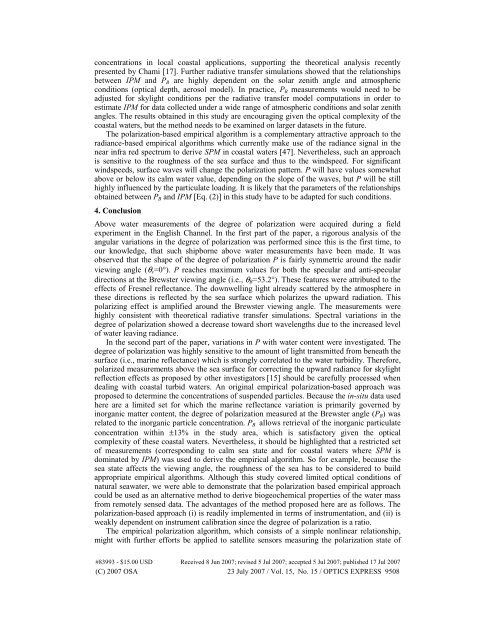Determination of biogeochemical properties of marine particles ...
Determination of biogeochemical properties of marine particles ...
Determination of biogeochemical properties of marine particles ...
Create successful ePaper yourself
Turn your PDF publications into a flip-book with our unique Google optimized e-Paper software.
concentrations in local coastal applications, supporting the theoretical analysis recently<br />
presented by Chami [17]. Further radiative transfer simulations showed that the relationships<br />
between IPM and P B are highly dependent on the solar zenith angle and atmospheric<br />
conditions (optical depth, aerosol model). In practice, P B measurements would need to be<br />
adjusted for skylight conditions per the radiative transfer model computations in order to<br />
estimate IPM for data collected under a wide range <strong>of</strong> atmospheric conditions and solar zenith<br />
angles. The results obtained in this study are encouraging given the optical complexity <strong>of</strong> the<br />
coastal waters, but the method needs to be examined on larger datasets in the future.<br />
The polarization-based empirical algorithm is a complementary attractive approach to the<br />
radiance-based empirical algorithms which currently make use <strong>of</strong> the radiance signal in the<br />
near infra red spectrum to derive SPM in coastal waters [47]. Nevertheless, such an approach<br />
is sensitive to the roughness <strong>of</strong> the sea surface and thus to the windspeed. For significant<br />
windspeeds, surface waves will change the polarization pattern. P will have values somewhat<br />
above or below its calm water value, depending on the slope <strong>of</strong> the waves, but P will be still<br />
highly influenced by the particulate loading. It is likely that the parameters <strong>of</strong> the relationships<br />
obtained between P B and IPM [Eq. (2)] in this study have to be adapted for such conditions.<br />
4. Conclusion<br />
Above water measurements <strong>of</strong> the degree <strong>of</strong> polarization were acquired during a field<br />
experiment in the English Channel. In the first part <strong>of</strong> the paper, a rigorous analysis <strong>of</strong> the<br />
angular variations in the degree <strong>of</strong> polarization was performed since this is the first time, to<br />
our knowledge, that such shipborne above water measurements have been made. It was<br />
observed that the shape <strong>of</strong> the degree <strong>of</strong> polarization P is fairly symmetric around the nadir<br />
viewing angle (θ v =0°). P reaches maximum values for both the specular and anti-specular<br />
directions at the Brewster viewing angle (i.e., θ B =53.2°). These features were attributed to the<br />
effects <strong>of</strong> Fresnel reflectance. The downwelling light already scattered by the atmosphere in<br />
these directions is reflected by the sea surface which polarizes the upward radiation. This<br />
polarizing effect is amplified around the Brewster viewing angle. The measurements were<br />
highly consistent with theoretical radiative transfer simulations. Spectral variations in the<br />
degree <strong>of</strong> polarization showed a decrease toward short wavelengths due to the increased level<br />
<strong>of</strong> water leaving radiance.<br />
In the second part <strong>of</strong> the paper, variations in P with water content were investigated. The<br />
degree <strong>of</strong> polarization was highly sensitive to the amount <strong>of</strong> light transmitted from beneath the<br />
surface (i.e., <strong>marine</strong> reflectance) which is strongly correlated to the water turbidity. Therefore,<br />
polarized measurements above the sea surface for correcting the upward radiance for skylight<br />
reflection effects as proposed by other investigators [15] should be carefully processed when<br />
dealing with coastal turbid waters. An original empirical polarization-based approach was<br />
proposed to determine the concentrations <strong>of</strong> suspended <strong>particles</strong>. Because the in-situ data used<br />
here are a limited set for which the <strong>marine</strong> reflectance variation is primarily governed by<br />
inorganic matter content, the degree <strong>of</strong> polarization measured at the Brewster angle (P B ) was<br />
related to the inorganic particle concentration. P B allows retrieval <strong>of</strong> the inorganic particulate<br />
concentration within ±13% in the study area, which is satisfactory given the optical<br />
complexity <strong>of</strong> these coastal waters. Nevertheless, it should be highlighted that a restricted set<br />
<strong>of</strong> measurements (corresponding to calm sea state and for coastal waters where SPM is<br />
dominated by IPM) was used to derive the empirical algorithm. So for example, because the<br />
sea state affects the viewing angle, the roughness <strong>of</strong> the sea has to be considered to build<br />
appropriate empirical algorithms. Although this study covered limited optical conditions <strong>of</strong><br />
natural seawater, we were able to demonstrate that the polarization based empirical approach<br />
could be used as an alternative method to derive <strong>biogeochemical</strong> <strong>properties</strong> <strong>of</strong> the water mass<br />
from remotely sensed data. The advantages <strong>of</strong> the method proposed here are as follows. The<br />
polarization-based approach (i) is readily implemented in terms <strong>of</strong> instrumentation, and (ii) is<br />
weakly dependent on instrument calibration since the degree <strong>of</strong> polarization is a ratio.<br />
The empirical polarization algorithm, which consists <strong>of</strong> a simple nonlinear relationship,<br />
might with further efforts be applied to satellite sensors measuring the polarization state <strong>of</strong><br />
#83993 - $15.00 USD Received 8 Jun 2007; revised 5 Jul 2007; accepted 5 Jul 2007; published 17 Jul 2007<br />
(C) 2007 OSA 23 July 2007 / Vol. 15, No. 15 / OPTICS EXPRESS 9508
















